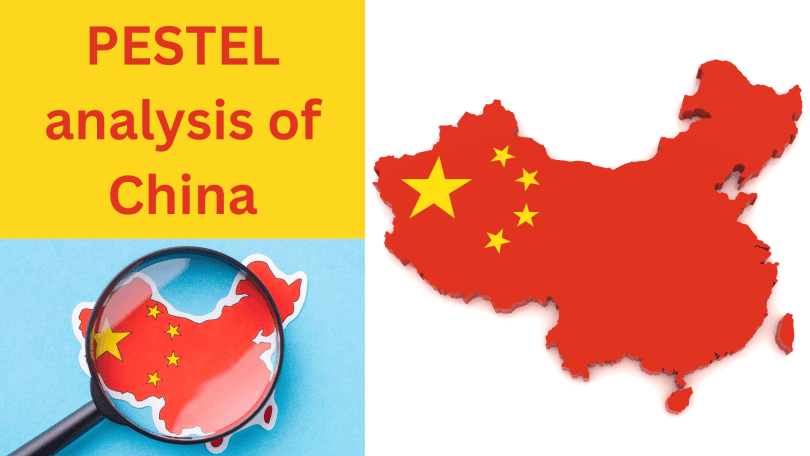The PESTEL analysis is a crucial tool for understanding the macroeconomic environment in which businesses operate, especially in China, one of the most dynamic and complex economies in the world.
With the rapid developments and persistent challenges facing China in 2025, a thorough analysis of this giant country will become crucially important for businesses already established in it and for new investors looking to venture into it.
In China, where government policies, economic trends, social dynamics, technological advancements, environmental issues, and legal frameworks are constantly evolving, a precise understanding of each aspect of the macroeconomic environment is indispensable for anticipating risks, seizing opportunities, and devising effective strategies.
Whether for companies seeking to consolidate their presence in the Chinese market or those considering investing there for the first time, a comprehensive PESTEL analysis of China provides the necessary insights to navigate this complex and competitive landscape.

Political factors
The Chinese political environment presents both opportunities and challenges for investors. Here’s a detailed breakdown of some key areas:
Opportunities:
Free trade agreements:
China has established numerous free trade agreements (FTAs) with various countries and regions, significantly enhancing its global trade network.
In addition to these bilateral agreements, China actively participates in major regional trade pacts such as the Regional Comprehensive Economic Partnership (RCEP) and the Belt and Road Initiative (BRI).
These agreements collectively expand China’s market access, allowing it to export products to new markets and boost its existing market share.
Furthermore, these FTAs attract foreign direct investment (FDI) into China, which stimulates economic growth and job creation.
By opening up its markets and fostering international trade relationships, China leverages these agreements to reinforce its economic position globally and promote sustained economic development.
Growing Domestic Consumption
The Chinese government is prioritizing the expansion of its domestic consumer base, creating a substantial market for consumer goods and services.
According to the National Bureau of Statistics of China, China’s retail sales of consumer goods reached ¥53.4 trillion (US$8.1 trillion) in 2023, an 8.0% increase year over year.
Additionally, e-commerce sales in China are projected to reach ¥18.7 trillion (US$2.8 trillion) in 2024, a 12% increase from the previous year, according to Statista.
Increased Investment in Technology and Innovation
China aims to establish itself as a global leader in technological innovation, opening doors for companies involved in AI, robotics, and other advanced technologies.
In 2022, China’s investment in research and development (R&D) reached ¥2.8 trillion (US$420 billion), a 14.2% increase from the previous year.
The Chinese government plans to invest ¥10 trillion (US$1.5 trillion) in artificial intelligence by 2030, according to South China Morning Pos.
Government Policies Supporting Strategic Industries
The Chinese government provides financial incentives and support to industries deemed strategically important, such as renewable energy, electric vehicles, and semiconductors.
In 2023, sales of new energy vehicles (NEVs) in China reached 5.5 million units, accounting for over 25% of the global market share. The government aims for NEVs to account for 50% of all new car sales by 2030.
Infrastructure Development Projects
Significant investment in infrastructure projects by the Chinese government creates opportunities for companies in construction, materials, and engineering.
China’s “Belt and Road Initiative” (BRI) is a vast infrastructure development program spanning multiple countries, offering considerable benefits for participating companies.
Infrastructure investment in China is expected to reach ¥7.5 trillion (US$1.1 trillion) in 2024, accounting for nearly 7% of GDP.
Environmental Policies and Green Technologies
China’s focus on environmental sustainability is driving demand for green technologies and solutions in renewable energy, pollution control, and waste management.
In 2023, China made significant investments in solar and wind power projects, with new installed capacity hitting record highs. The renewable energy sector in China is projected to create over 10 million new jobs by 2030.
Healthcare Sector Reforms
The Chinese government’s healthcare reforms are leading to increased investment in hospitals, medical equipment, and pharmaceuticals. In 2023, China launched initiatives to expand health insurance coverage and improve access to affordable medication.
The Chinese healthcare market is expected to reach ¥18 trillion (US$2.7 trillion) by 2025, growing at an annual rate of 10%.
Threats:
The political environment in China presents some serious threats to investors. Here’s a look at some key current and potential threats:
Geopolitical Tensions
Rising tensions with the US and other countries can disrupt trade flows, create market volatility, and impact investment decisions.
The ongoing trade war between the US and China has resulted in tariffs and import restrictions on billions of dollars of goods, affecting businesses in both countries.
A 2023 survey by the American Chamber of Commerce in China found that 60% of member companies reported being negatively impacted by the trade war.
Regulatory Uncertainty and Opaque Policy Shifts
The Chinese government can implement regulations and policy changes quickly, creating uncertainty for foreign investors. In 2021, China’s crackdown on the technology sector led to significant stock market losses and a more cautious approach by foreign investors in the tech industry.
A 2024 report by the European Union Chamber of Commerce in China found that 72% of member companies expressed concerns about the regulatory environment’s unpredictability.
Government Control over Information
The Chinese government restricts access to certain information and can control online content, which can limit transparency and make it difficult for businesses to make informed decisions.
Foreign news websites and social media platforms are often inaccessible in China. The Freedom House 2024 report ranks China as “Not Free” in terms of internet freedom.
These are just some of the potential threats, and the specific risks can vary depending on the industry and sector you invest in. Staying informed about political developments, conducting thorough due diligence, and seeking professional advice can help investors mitigate these risks.
Economic factors
China’s economic environment offers a complex picture for businesses. Here’s a breakdown of key aspects:
The official urban unemployment rate in China sits around 5% as of April 2024. However, this figure might only partially capture the complete picture. A moderate unemployment rate can be positive for businesses, offering a pool of potential hires.
Concerns exist about a potential hidden unemployment issue: discouraged workers who are not actively seeking jobs are impacting the availability of skilled labor.
Also, Consumer Price Index (CPI) inflation in China has been relatively stable, hovering around 2% as of April 2024. Low inflation can be favorable for businesses, allowing for more predictable costs.
However, rising global commodity prices due to factors like the war in Ukraine could put upward pressure on inflation in the future, impacting business costs and consumer spending.
China’s economic growth is projected to be slower in the coming years compared to its historically high rates. This could dampen overall business activity.
Wage growth has slowed down in China compared to previous years. While this can benefit businesses in terms of labor costs, it can also impact domestic consumption if disposable income stagnates.
China’s high corporate debt levels pose a potential risk to overall economic stability and could impact businesses’ access to credit. Rising global commodity prices can increase the cost of raw materials for businesses, impacting their profit margins.
Specific skilled labor shortages can hinder businesses in certain sectors like technology and manufacturing despite a moderate overall unemployment rate.
Slower economic growth and stagnant wages could lead to reduced consumer spending, impacting businesses that rely on domestic demand.
Social factors
Sociocultural factors influencing your business in China are numerous and diverse.
Growing and aging population
China has 1.4 billion inhabitants, or 18% of the world’s population, with a growing middle class. This represents a huge market for products and services.
However, the population is aging, with an increase in the number of dependent older adults, which is affecting the demand for certain products and putting pressure on health and social security systems.
Rise of the middle class
The Chinese middle class is growing rapidly, with increasing purchasing power and aspirations. This creates opportunities for businesses offering high-end products and services.
This middle class is more educated and connected, eager for new experiences and lifestyles. Businesses must adapt to these preferences and adopt an effective digital marketing approach.
Increasing urbanization
The rural exodus is intensifying, with over 60% of the population now living in cities. This is driving demand for housing, infrastructure, consumer goods, and urban services.
Urban areas concentrate on business and innovation centers, offering opportunities for businesses that establish themselves in these areas.
Importance of family and relationships
Family ties and personal relationships are essential in Chinese culture. Businesses must build trust and establish lasting relationships with their customers and partners. Word-of-mouth and recommendations are powerful marketing channels in China.
Value of education and success
Education is highly valued in China, and university graduates are in high demand. Businesses can attract and retain top talent by offering development and training opportunities. Social and economic success is important to the Chinese, and it influences their consumption choices.
Importance of brand image and reputation
Chinese consumers are sensitive to brand image and reputation. It is crucial to maintain a positive image and engage in ethical and responsible business practices. Social media and online platforms play a crucial role in building and managing a company’s reputation in China.
Technological factors
Rapid technological advancement:
China is a global leader in technological innovation, with significant investments in research and development. This creates a dynamic environment for businesses, offering opportunities to adopt new technologies and improve their products and services.
Examples include the deployment of 5G networks, advancements in artificial intelligence, and the growth of e-commerce.
Large and tech-savvy population:
China has the world’s largest internet population, with over 1 billion users. This presents a vast market for technology-enabled products and services. As of January 2024, there are 1.12 billion internet users in China.
Strong government support for technology:
The Chinese government prioritizes technological development, providing funding, incentives, and favorable policies for tech companies. This creates a supportive environment for businesses to innovate and grow, with initiatives like the “Made in China 2025” strategy and the national AI development plan.
E-commerce and digital payments:
China’s e-commerce market is the largest and most sophisticated globally, driven by platforms like Alibaba and Tencent. Digital payments are also widely adopted, with mobile wallets like Alipay and WeChat Pay. China’s e-commerce market reached USD 13.5 trillion in 2023.
Emerging technologies:
Additionally, China is at the forefront of developing and adopting emerging technologies such as artificial intelligence, blockchain, and the Internet of Things, offering businesses opportunities to gain a competitive edge.
The technological landscape in China presents both opportunities and challenges for businesses. By understanding and adapting to these factors, companies can leverage technological advancements to enhance their operations, expand their customer base, and gain a competitive edge in the Chinese market.
Environmental factors
Environmental factors significantly impact businesses in China, posing challenges such as air and water pollution, soil contamination, and waste management issues.
These environmental concerns can lead to increased costs for pollution control measures, reputational risks, and disruptions in the supply chain. For instance, major cities often experience smog, rivers suffer from water pollution, and hazardous waste disposal presents ongoing challenges.
Another pressing concern is resource scarcity. China’s heavy reliance on resources like water, energy, and raw materials, coupled with growing demand, can result in shortages and price fluctuations.
This affects businesses dependent on these resources, as evidenced by water shortages, escalating energy costs, and reliance on imported raw materials.
Climate change exacerbates these challenges, posing risks such as extreme weather events, rising sea levels, and shifts in precipitation patterns.
These environmental changes can damage infrastructure, disrupt supply chains, and alter consumer demand. Notable occurrences include frequent floods, droughts, and typhoons that impact various sectors.
To address these issues, the Chinese government is enforcing stricter environmental regulations to promote sustainable development. While compliance poses challenges for businesses, it also presents opportunities through government incentives for eco-friendly practices.
Noteworthy measures include industry emission standards, city air quality regulations, and policies supporting renewable energy initiatives.
Furthermore, there’s a growing consumer demand for sustainability in China. With consumers increasingly prioritizing environmentally friendly products and services, businesses have the opportunity to capitalize on this trend.
This is evident in the rising popularity of organic food, the demand for energy-efficient appliances, and the interest in eco-tourism.
Legal factors
Legal factors play a significant role in shaping business operations in China. The country’s legal system is intricate and continually evolving, presenting challenges for foreign businesses.
Complex and evolving legal system:
Companies must seek legal guidance to ensure compliance with the ever-changing laws and regulations. Examples of this complexity include frequent revisions to labor laws, intellectual property regulations, and data privacy laws.
Strong emphasis on intellectual property protection:
Intellectual property protection is a paramount concern in China. While the country has made strides in strengthening IP laws, issues such as counterfeiting and trademark infringement persist.
Efforts to combat these challenges include crackdowns on counterfeit goods and an increase in patent and trademark filings.
Strict data privacy regulations:
China has implemented strict data privacy regulations, notably with the enactment of the Personal Information Protection Law (PIPL) in 2021.
This law imposes rigorous requirements for the collection, usage, and storage of personal data, including data localization mandates, consent mechanisms, and data breach notification obligations.
Labor laws and regulations:
Labor laws in China offer extensive protections for workers, covering areas like minimum wage, overtime, and social insurance benefits.
Regular adjustments to minimum wage rates, limitations on overtime work, and mandatory contributions to social insurance programs are among the key aspects of labor regulations.
Contract law:
Contract law in China is well-developed, with courts generally supportive of contractual obligations. However, businesses need to draft clear and enforceable contracts covering various contract types, ensure the enforcement of contractual terms, and incorporate effective dispute-resolution mechanisms.
Recent statistics underscore the significance of these legal factors. For instance, in 2023, China witnessed over 7.5 million patent applications and 5.8 million trademark applications.
Additionally, the country’s cyberspace regulator imposed substantial fines for violations of data privacy regulations, and Chinese courts handled numerous labor dispute cases.
In conclusion, navigating the legal environment in China requires businesses to grasp both the challenges and opportunities it presents.
Compliance with the legal framework enables companies to operate confidently, safeguard their intellectual property, and effectively manage their workforce.
Conclusion
While the PESTEL analysis provides a comprehensive framework for understanding the macroeconomic environment in China, it is essential to complement this analysis with other studies and analyses to gain a holistic and clear understanding of the business landscape.
Conducting a SWOT analysis of your company allows you to identify its strengths, weaknesses, opportunities, and threats within the context of the Chinese market, helping to formulate strategies that capitalize on strengths and opportunities while mitigating weaknesses and threats.
Additionally, analyzing the competitive forces within your industry using Michael Porter’s Five Forces framework provides valuable insights into the dynamics of competition in the Chinese market.
By assessing factors such as the bargaining power of suppliers and buyers, the threat of new entrants, the threat of substitutes, and the intensity of rivalry among competitors, you can develop strategies to enhance your competitive position and achieve sustainable success.
By combining the findings from these various analyses, businesses can develop a comprehensive understanding of the opportunities and challenges present in the Chinese market and formulate informed strategies to navigate them effectively.
This integrated approach ensures that companies have a clear and holistic view of the business environment, enabling them to make strategic decisions that drive growth and profitability in China’s dynamic and competitive environment.
Read also: SWOT analysis of China in 2025.
PESTEL analysis examples 2025
To better understand the PESTEL analysis, we invite you to read our recent free examples of the Pestel framework.
PESTEL analysis of Coca-cola
Click here to read our example of Coca-cola PESTEL analysis.
PESTEL analysis of British Airways
Click here to read our example of British Airways PESTEL analysis.
PESTEL analysis of Primark
Click here to read our example of Primark’s PESTEL analysis.
PESTEL analysis of Zara
Click here to read our example of Zara’s PESTEL analysis.
PESTEL analysis of DHL
Click here to read our example of DHL’s PESTEL analysis.
PESTEL analysis of FedEx
Click here to read our example of FedEx’s PESTEL analysis.
PESTEL analysis of Chipotle
Click here to read our example of Chipotle’s PESTEL analysis.
PESTEL analysis of Brazil
Click here to read our example of Pestel’s analysis of Brazil.
PESTEL analysis of Spotify
Click here to read our example of Spotify Pestel analysis.
Chick-fil-A PESTEL Analysis
Click here to read our example of Chick-fil-A Pestel analysis.
Costco PESTEL Analysis
Click here to read our example of Costco Pestel analysis.
Microsoft PESTEL Analysis
Click here to read our example of Microsoft Pestel analysis.
Disney PESTEL Analysis
Click here to read our example of Disney Pestel analysis.
Airline Industry PESTEL Analysis
Click here to read our example of the Airline industry Pestel analysis.
Walmart Pestel Analysis
Click here to read our example of Walmart Pestel analysis.
Amazon Pestel Analysis
Click here to read our example of Amazon Pestel analysis.
McDonald’s Pestel Analysis
Click here to read our example of the Netflix Pestel analysis.
Netflix Pestel Analysis
Click here to read our example of the Netflix Pestel analysis.
Apple Pestel Analysis
Click here to read our example of the Apple Pestel analysis.
Twitter Pestel Analysis
Click here to read our example of the Twitter Pestel analysis.
Facebook Pestel Analysis
Click here to read our example of the Facebook Pestel analysis.
Pestel analysis of the Social Media industry
Click here to read our example of the Pestel analysis of the Social Media industry.
Ikea Pestel Analysis
Click here to read our example of the IKEA Pestel analysis.
Tesla Pestel Analysis
Click here to read our example of the TESLA Pestel analysis.












Leave a Comment